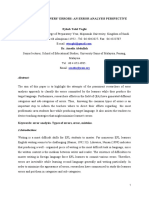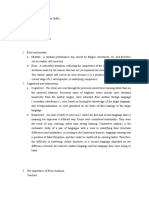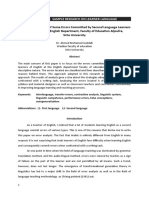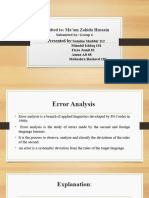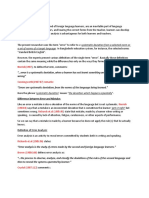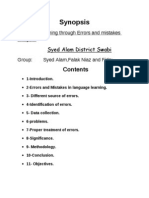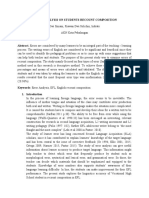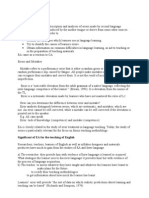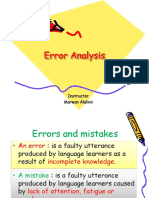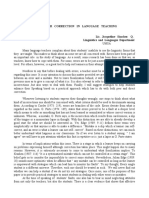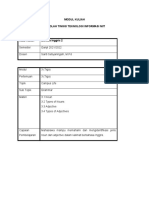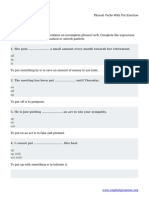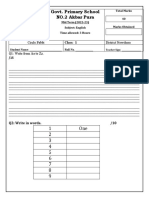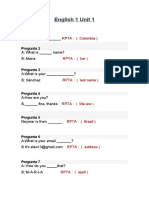- –
Error analysis effectiveness in learning
Dr. Zohra Benamor
University of Tlemcen
Abstract:
Errors mainly grammatical errors are no longer considered as indications of failure. Rather,
they form fundamental foundations for improving learning. Thus, teachers should set
appropriate tasks that can really engage and reflect pupils’ grammatical ability and have a
positive effect on learning. EFL learners make errors during the process of developing their
language. This seems to be an expected and usual part of language learning. However, what is
significant is to know how these errors can be exploited to benefit grammar learning. This can be
through Error Analysis. So, what is this method? Have researchers focused on just one model?
What are the common sources of such errors? And how can it be an effective means to improve
grammatical accuracy.
Key words: Error analysis; grammatical errors ; learning; EFL learners ; sources of errors
.
.
.
. .
. .
. :
Résumé:
Les erreurs principalement grammaticales ne sont plus considérées comme des signes d'échec.
Elles constituent plutôt des fondements fondamentaux pour améliorer l'apprentissage. Ainsi, les
enseignants devraient définir des tâches appropriées qui peuvent réellement s'engager et refléter
la capacité grammaticale des élèves et avoir un effet positif sur l'apprentissage. Les apprenants
d'EFL font des erreurs pendant le processus de développement de leur langue. Cela semble être
une partie attendue et habituelle de l'apprentissage des langues. Cependant, ce qui est important,
c'est de savoir comment ces erreurs peuvent être exploitées au profit de l'apprentissage de la
grammaire. Cela peut se faire par analyse d'erreur. Alors, quelle est cette méthode et ses
antécédents? Les chercheurs se sont concentrés sur un seul modèle? Quelles sont les sources
communes de telles erreurs? Et comment peut-il être un moyen efficace d'améliorer la précision
grammaticale.
Introduction:
Errors mainly grammatical errors are no longer considered as indications of failure.
Rather, they form fundamental foundations to target specific points that require specific
reinforcement and tailor teaching for the purpose of improving the teaching learning process.
Thus, when designing tests, or at least tasks in assignments , it is very important to take into
consideration important necessities that a good test should possess. In addition to reliability,
construct validity, authenticity, and practicality, good tests should engage pupils’ grammatical
452 2019
� - –
ability and have a positive effect on learning. Hence, the choice of the appropriate tasks that can
really reflect the learners’ grammatical ability may be one the most difficulties that face
educators when assessing their pupils’ grammatical ability since they ought to provide not only
some specific grammar areas but a detailed idea about their general grammar. More importantly,
teachers need to decide in advance the construct to be assessed, areas to be focused on and the
ways to deal with responses. One of these ways is error analysis as a way to improve learning.
EFL learners make mistakes and errors during the process of developing their language. This
seems to be an expected and usual part of language learning as a completely different opinion
has occurred to consider learners’ errors as an indicator of their learning process and as a device
to improve learning (Corder, 1974). What is significant is to know how these errors can be
exploited to benefit both grammar teaching and testing.
1- The distinction between error and mistake
Before moving to the theoretical background of this method, its models and sources of errors, it
is important to make a distinction between the terms mistake and error. Most people consider
them as synonyms, but indeed they are different from each other. The distinction between them
relies on the ability of self-correction. This is what is called by Corder (1971) and James (1998)
as the self- correctability criterion (as cited in AbiSamra, 2003). Mistakes can be self- corrected,
but, errors cannot. However, Harmer (2007, p. 96) uses them as a broad term that refers to three
categories; slips that are mistakes which learners can correct themselves when noticing them,
errors that are mistakes which pupils cannot recognize as errors and cannot correct themselves
and attempts that are mistakes which pupils make when they attempt to do something but they do
not know how. Thus, error as defined by Ellis (1994) is a systematic and repeated deviation from
the norms of the target language.
2- Error Analysis
The analysis of errors that language learners make has been one of the most controversial issues
in the field of applied linguistics for a long time. According to Keshavarz (1999), there have
been two major approaches of studying language learners’ errors; Contrastive Analysis (CA) and
Error Analysis (EA). Through CA method, errors that learners make can be predicted by
comparing the linguistic differences between the mother tongue and the target language (kim,
2001, as cited in Heydari and Bagheri, 2012). However, studies showed that not all errors
resulted from L1 habits transfer, there were many others that appeared during the process of
learning which had no relation with L1 (Ellis, 1994). Therefore, by the early 1970’s, it was
replaced by EA because of its inaccuracy and the high criticism that it received (kim, 2001, as
cited in Heydari and Bagheri, 2012).
The shortcoming of CA gave birth to Error Analysis. In this vein, Corder (1984) claims that
thanks to CA, the focus shifted from the concern of teaching towards a study of learning (as cited
in Tomková, 2013). In this way, it is viewed as a technique that provides evidence of the
learner’s knowledge of the second language (Ellis, 1994). In fact, its purpose is to find out what
learners know and what they do not know (Corder, 1974). Ellis and Barkhuizen describe error
analysis as “a set of procedures for identifying, describing, and explaining learners’ errors”
(2005, p. 51). This explanation involves mainly identifying the sources of such errors for the
purpose of the adaptation of appropriate teaching strategies to help language learners learn better
(Heydari and Bagheri, 2012).
3- Why focusing on grammatical errors?
Learning grammar is the most essential part in learning a language. In order to be able to use a
language properly, it is necessary to master its grammar. That is why error analysis mainly
focuses on grammatical errors (Hasyim, 2002). According to (Brown, 2000, p. 217) an error is a
noticeable deviation from the adult grammar of a native speaker. In fact, “knowing more about
how grammar works is to understand more about how grammar is used and misused” (Carter,
453 2019
� - –
1997, p. 35). Thus, knowing more about pupils’ grammar knowledge helps a lot in improving
their grammar competence. This has been proved by many researches which have confirmed that
emphasizing on learners’ errors is an effective means to improve grammatical accuracy (White et
al, 1991; Carroll and Swain, 1993, as cited in Hourani, 2008). In this respect, “systematically
analyzing errors made by language learners makes it possible to determine areas that need
reinforcement in teaching” (Mungungu, 2010, p. 12). In fact, it does not seek only to determine
areas of difficulties, but it attempts to find out the reasons behind such difficulties for the
purpose of identifying strategies which learners use in language learning, identifying the causes
of learners errors and obtaining information on common difficulties in language learning as a
basis for teaching or preparing teaching materials (Richards and Schmidt, 2002).
4- Steps of error analysis
Since error analysis appeared as a systematic study, it was necessary to base it on well-defined
procedures. Corder as the founder of this new trend, sets a model to analyze errors. According to
Ellis, his model involves the following steps:
1- Collection of a sample of learner language
2- Identification of errors
3- Description of errors
4- Explanation of errors
5- Evaluating errors (1994, p. 48)
Ellis (1994, pp. 49-66) clarifies what each step includes. Accordingly, the first step is to decide
what learner language sample is useful for the study either samples of a large number of learners,
or of a limited number of learners or just one sample of a single learner. Concerning the way of
collecting them, they can be collected from natural language use or elicited in some way. The
second step is to identify the error through distinguishing between errors and mistakes, and
between overt and covert errors and through deciding in advance what errors wanted to be dealt
with; either errors of correctness or of appropriateness. The third step is to focus only on the
observable features of errors in the learners’ idiosyncratic utterances compared with those
utterances in the target language. The simplest type of description is based on linguistic
categories and subcategories such as the auxiliary system which is subdivided into do, have and
be. An alternative to linguistic description is surface strategy taxonomy suggested by Dulay et al
(1982), in which four broad categories are suggested; omissions, additions, misformation and
misordering. However, it may be sometimes difficult to determine the type of the error.
Consequently, it depends on the researcher’s reconstruction of the sentence to identify the error
type. This stage includes also a quantification of the types of errors. The fourth step refers to
establishing the sources of errors. In this vein, Taylor (1986) identifies some error sources that
may be psycholinguistic, sociolinguisic, epistemic (lack of world knowledge), or in discourse
structure (problems in information organization) (as cited in Ellis, 1994, p. 57).
According to Dodigovic (2005), many researchers were elaborated on Corder’ s model such as
Brown (1994) and Ellis (1995). Some of them provided clear examples of how to conduct the
study such as Hubbard et al (1996) and Ellis (1997). However, Gass and Selinker (1994)
identified six steps followed in conducting an error analysis; collecting data, identifying errors,
classifying errors, quantifying errors, analyzing source of error and remediating for errors (as
cited in AbiSamra, 2003). Another model was proposed by While Sridhar (1980) that includes
six steps. They are collection of data from composition or exam answers, identification of errors
with respect to the exact nature of the deviation, classification into error types, statement of
relative frequency of error type, identification of areas of difficulty in the target language and
finally therapy with remedial drills and lessons (as cited in Hourani, 2008).
The major aim of error analysis is to improve foreign language learning through pointing at the
main areas of difficulties. In this respect, Corder (1974) claims that systematically analyzing
errors made by language learners makes it possible to determine areas that need reinforcement in
454 2019
� - –
teaching (as cited in AbiSamra, 2003). However, for setting appropriate remedies, it is essential
to identify the main sources of committing errors.
5- Sources of errors
An important stage in error analysis procedures is identifying the sources of errors. Several
studies have been conducted to suggest different reasons why errors occur, in which the one
done by Richards (1971) may be the first and most important (Heydari and Bagheri, 2012).
According to them, he differentiated three sources of errors. First, interference errors result from
the use of elements from the native language when speaking or writing another. Second,
intralingual errors reflect the general characteristics of rule learning such as overgeneralization
of rules, incomplete application of rules, ignorance of rule restrictions and false hypothesis.
Third, developmental errors occur during the process of building hypothesis about the target
language. However, the distinction between intralingual errors and developmental errors seems
to be unclear (Schacheter and Celce-Murcia, 1977, as cited in Ellis, 1994). Accordingly,
Richards (1974) classifies errors according to their sources into two categories: interlingual
errors caused by mother tongue interference and intralingual and developmental errors caused
during the process of second language learning or caused because the difficulty of the language
itself (as cited in Heydari and Bagheri, 2012).
It is not easy to make differences between interlingual and intralingual errors. Furthermore, it is
more difficult to make a difference between the different types of intralingual errors. As a result,
other experts proposed other categories of learners’ errors (Ellis, 1994). However, most
researchers based their classification of categories on Richards’ division and they elaborated
their own classifications (Heydari and Bagheri, 2012).
However, it is not easy to identify the real sources of errors, but an attempt to understand the
errors and to use what is learned from them and from the learners explanations themselves can
help to improve language learning since “if clear explanatory statements about errors are often
not possible, the value of EA as a tool for investigating L2 acquisition is thrown into question”
(Ellis, 1994, p. 63). Furthermore, previous studies mainly with similar learners can help a lot to
conduct error analysis with particular groups.
Conclusion
To sum up, error analysis helps in facilitating second language learning through improving
language competence since it has been proved that it is an effective means to improve
grammatical accuracy. Educators should know the developmental sequences of acquiring some
structures so as to expect the possible errors to set appropriate and remedial responses since most
of SLA researchers (e.g. Clahsen (1985), Pienemann and Johnson (1987), Ellis (2001b) ) claim
that structures seem to be learned in a fixed developmental sequences (as cited in Pupura, 2004).
Thus, language teachers should take this into consideration when evaluating grammar responses
and avoid to consider them as right or wrong if there are some correct points in their responses.
However, testees who have an intermediary knowledge of grammar are being treated as if they
have no knowledge at all. That’s why, some researchers such as Clahsen (1985) suggest that
structures should be measured in a way in which they are selected and graded in terms of their
order in developmental sequences in a way such as partial scoring (as cited in Purpura, 2004). In
this way and through error analysis, this plays an important role in helping mainly learners to
construct self-correction and self-development techniques.
455 2019
� - –
References:
- AbiSamra, N. (2003). An Analysis of Errors in Arabic Speakers’ English Writings.
Beirut: American University of Beirut
- Brown, H. D. (2000). Principles of Language Learning and Teaching, 4th Ed. White
Plains, New York: Longman.
- Carter, R. (1997). ‘The new grammar teaching’ in Carter R Investigating English
Discourse Routledge, London
- Corder, S. P. (1974). Error Analysis: Perspectives on Second Language Acquisition.
London: Longman
- Dodigovic, M. (2005). Artificial Intelligence in Second Language Learning: Raising
Error Awareness. Clevedon: Multiling Matter
Dulay, H, C., Burt, M. K., Krashen, S. D. (1982). Language Teaching. Oxford: Oxford
University Press.
- Ellis, R. (1994). The Study of Second Language Acquisition. Oxford: Oxford University
Press
- Ellis, R., and Barkhuizen, G. (2005). Analysing Learner Language. Oxford: Oxford
University Press
- Harmer, J. (2007). How to Teach English. England: Pearson Education Limited
- Hasyim, S. (2002). Error Analysis in the Teaching of English. k@ta, Vol 4 No 1 pp. 42-
50. Jurusan Sastra, Universitas Kriten Petra.Heydari and Bagheri, 2012).
- Heydari, P., and Bagheri, M. S. (2012). Error Analysis: Sources of L2 Learners’ Errors.
Theory and Practice in Language Studies, Vol. 2 No 8, pp. 1583-1589.
- Hourani, T. M. Y.( 2008). An Analysis of the Common Grammatical Erros in the English
Writing made by 3rd Secondary Male Pupils in the Eastern Coast of the UAE. The British
University in Dubai
- Keshavarz, M. D. (1999). Contrastive Analysis and Error Analysis (6th ed). Tehran:
Rahnama Press.
- Mungungu, S.S. ( 2010). Error Analysis: Investigating the Writing of ESL Namibian
Learners. University of South Africa.
- Purpura, J. E. (2004). Assessing Grammar. Cambridge: Cambridge University Press.
- Richards, J. C., and Schmidt, R. (2002). Dictionary of Language Teaching and Applied
Linguistics. Pearson Education Limited. London: Longman.
- Tomková, G. (2013). Teaching English Language and Literature for Secondary Schools. .
Brno: Masaryk University.
456 2019

